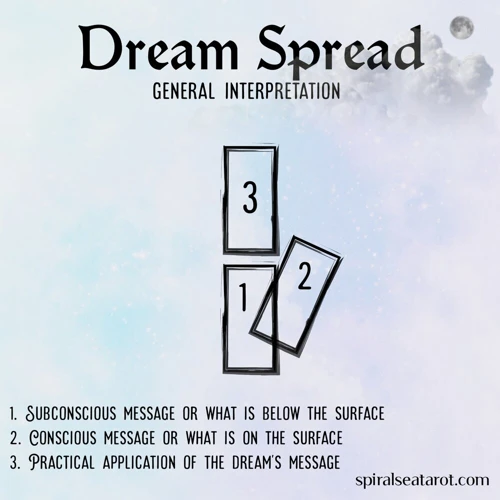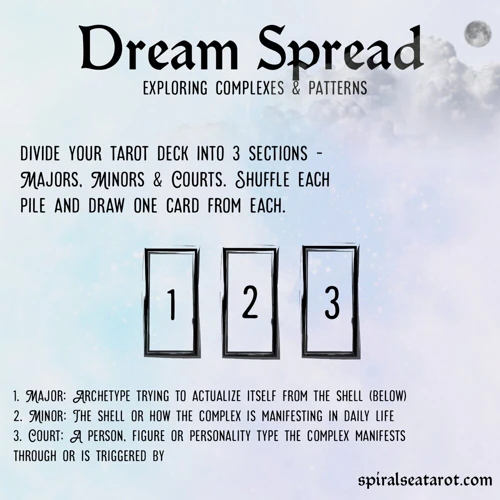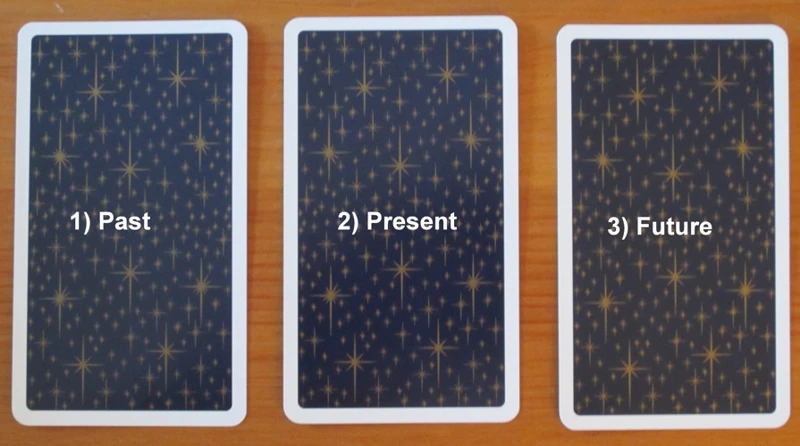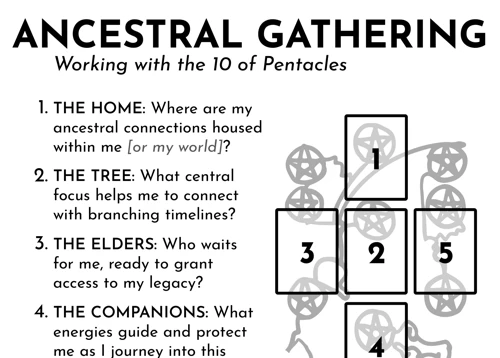Delving into the mysteries of the dream world and deciphering their hidden meanings has captivated humans since ancient times. One alluring method of unraveling the secrets held within our dreams is through dream spreads, a unique and intriguing practice. By understanding the significance of card positions in dream spreads, we can gain valuable insight into our subconscious thoughts and emotions. In this comprehensive article, we will explore the basics of dream spreads, the importance of card positions, and how to interpret them for a comprehensive understanding of our dreams. So, prepare to embark on a journey of self-discovery as we unravel the enigmatic realm of dream spreads and unlock the insights they hold.
Contents
- The Basics of Dream Spreads
- Understanding Card Positions
- Interpreting Dream Spreads
- Putting It All Together
- Tips and Tricks
- Conclusion
-
Frequently Asked Questions
- 1. What is the significance of card positions in dream spreads?
- 2. How do dream spreads differ from traditional tarot readings?
- 3. Can I use any type of tarot deck for dream spreads?
- 4. Are dream spreads suitable for beginners?
- 5. What if I don’t remember my dreams? Can I still use dream spreads?
- 6. How long does it take to learn how to interpret dream spreads?
- 7. Can dream spreads predict the future?
- 8. Is it possible to have multiple interpretations for the same card position?
- 9. Should dream spreads be done alone or with a tarot reader?
- 10. Can dream spreads be used for lucid dreaming?
- References
The Basics of Dream Spreads

Dream spreads are a fascinating technique for unraveling the hidden intricacies of our dreams. To fully grasp the significance of card positions in dream spreads, it is crucial to understand the basics of this practice. Dream spreads involve the use of tarot cards to gain insight into our subconscious thoughts and emotions. Each card holds symbolic meanings that can shed light on different aspects of our dreams. The cards are laid out in specific positions, which play a crucial role in interpreting the overall message of the spread. Whether it’s a simple three-card spread or a more complex Celtic Cross spread, each card position carries its own significance and adds depth to the interpretation. By familiarizing ourselves with the fundamentals of dream spreads, we can embark on a journey of self-discovery and learn to unlock the hidden meanings within our dreams. To learn how to create your own dream spread using tarot cards, check out this helpful guide.
1. What are Dream Spreads?
Dream spreads are a unique and powerful method for exploring the depths of our dreams and gaining profound insight into our subconscious minds. These spreads involve the use of tarot cards, which have been used for centuries to tap into our intuition and unlock hidden meanings. Dream spreads, specifically tailored for dream interpretation, provide a structure for laying out the tarot cards in a way that represents different aspects of our dreams. Each card in the spread is carefully chosen to symbolize different elements, themes, or emotions related to the dream. The arrangement of the cards adds an additional layer of meaning, as the position of each card impacts its interpretation. Dream spreads offer a structured framework for organizing and analyzing the intricate symbolism and messages present in our dreams. By using dream spreads, individuals can more effectively delve into the depths of their dreams and uncover the profound wisdom that lies within. For a deeper understanding of how tarot card readings can help unlock hidden meanings in dreams, check out this informative article.
2. How Do Dream Spreads Work?
Dream spreads are a powerful tool for uncovering the hidden meanings within our dreams. But how exactly do they work? Dream spreads operate under the concept that our dreams are not random, but rather a reflection of our subconscious mind. These spreads utilize tarot cards, each with its own symbolic meaning, to decode the messages embedded within our dreams. When performing a dream spread, cards are drawn and placed in specific positions that correspond to different aspects of the dream. For example, a card may represent the emotions felt in the dream, while another may symbolize the underlying motivations or conflicts. The cards are then interpreted in relation to their positions, forming a narrative that helps us understand the deeper meaning of our dream. One popular dream spread method is the Celtic Cross spread, which provides a comprehensive analysis of the dream’s themes and influences. To learn more about interpreting dreams using the Celtic Cross spread, check out this insightful guide. By understanding how dream spreads work and practicing their interpretation, we can gain valuable insights into our subconscious mind and embark on a journey of self-discovery.
3. Popular Types of Dream Spreads
Dream spreads offer a wide range of options for exploring the depths of our dreams and gaining insight into their meanings. Here are some popular types of dream spreads that tarot enthusiasts commonly utilize:
- Three-Card Spread: This simple yet powerful spread consists of three cards, each representing the past, present, and future. It offers a concise snapshot of the dream’s narrative and provides guidance on how past experiences may be influencing present circumstances, as well as the potential outcomes in the future.
- Celtic Cross Spread: Considered one of the most comprehensive spreads, the Celtic Cross spread is perfect for diving deep into the layers of a dream. It features ten cards that represent various aspects of the dreamer’s subconscious and external circumstances. From the central card symbolizing the present situation to the crowning card revealing the ultimate outcome, this spread paints a detailed picture of the dream’s significance and possible implications.
- Elemental Spread: This unique spread focuses on the elemental associations of the tarot cards – earth, air, fire, and water. Each card position represents different elemental energies present in the dream, offering insights into the dreamer’s emotional state, intellectual pursuits, material concerns, and spiritual growth. The Elemental Spread provides a holistic perspective on the dream, allowing for a comprehensive analysis.
- Past-Present-Future Spread: Similar to the three-card spread, this variation provides a broader perspective by delving deeper into the past and the future. Each card corresponds to a specific timeframe, unraveling the roots of the dream, the current influences, and the potential trajectory. It assists dream interpreters in understanding the dreamer’s journey and how it connects to their present circumstances.
These are just a few examples of popular dream spreads, but the possibilities are endless. Experimenting with different spreads can bring new dimensions to dream interpretation and open doors to deeper revelations. Each spread offers a unique lens through which to examine dreams, so feel free to explore and find the spreads that resonate with you the most. To learn more about interpreting dreams using the Celtic Cross spread, check out this comprehensive guide.
Understanding Card Positions

To truly grasp the significance of card positions in dream spreads, it is essential to delve into the intricacies of their meaning. Each card position in a spread holds a unique significance that adds depth to the interpretation of our dreams. Understanding card positions can be approached in various ways, such as through the use of an intuitive table or a comprehensive list. In a table format, each card position can be represented with its corresponding meaning, allowing for a clear visual representation and easy comparison. Alternatively, a list format can provide a concise breakdown of each card position and its significance. Both approaches allow us to navigate through the complexities of dream spreads and unravel the intricate messages hidden within the cards. By comprehending the significance of individual card positions, we can embark on an enriching journey of interpretation and gain a deeper understanding of our dreams and their underlying meanings.
| Card Position | Significance |
|---|---|
| Position 1 | Represents the dreamer’s current state of mind and emotions. |
| Position 2 | Sheds light on the underlying forces or influences at play in the dream. |
| Position 3 | Reveals the conscious desires or aspirations of the dreamer. |
4. Why Card Positions Matter
Understanding why card positions matter is crucial in the interpretation of dream spreads. Each position in a dream spread represents a specific aspect or perspective on the dreamer’s subconscious thoughts and emotions. By assigning cards to these positions, we can gain deeper insights into different aspects of the dream’s meaning. Let’s explore the significance of card positions:
- The Past Position: This position represents the past influences that have shaped the dreamer’s current situation. It provides insights into past experiences or events that may be impacting the dreamer’s subconscious mind.
- The Present Position: As the name suggests, this position reflects the current state of affairs for the dreamer. It offers a snapshot of the dreamer’s present thoughts, feelings, and emotions.
- The Future Position: Positioned to offer a glimpse into what lies ahead, the future position helps provide guidance and potential outcomes based on the current trajectory of the dreamer’s subconscious.
- The Internal Position: This position delves into the dreamer’s internal thoughts, desires, and conflicts. It explores the dreamer’s inner world and sheds light on their hopes, fears, and desires.
These positions, along with others that can be added based on the specific dream spread being used, contribute to a comprehensive interpretation. By analyzing each card in its designated position, we can gain a more nuanced understanding of the dream’s meaning, allowing us to uncover hidden insights and messages that may have been otherwise overlooked. The card positions serve as a roadmap, guiding us to explore different aspects of the dreamer’s subconscious landscape, bringing greater clarity and understanding to our dream interpretations.
5. The Significance of Individual Card Positions
In dream spreads, the individual card positions within a spread hold great significance and contribute to the overall interpretation of the dream’s message. Each position represents a specific aspect or theme related to the dream, allowing for a more focused analysis. The first card position, for example, may symbolize the overall theme or main message of the dream. It provides a foundation upon which the other cards and their positions build upon. The second position could represent the emotions or feelings experienced in the dream, offering insight into the dreamer’s state of mind. Meanwhile, the third position might reveal the obstacles or challenges that the dreamer is currently facing in their waking life. As the spread progresses, subsequent positions delve deeper into the various aspects of the dream, exploring relationships, desires, or even hidden influences. By interpreting each card in its specific position, we gain a more nuanced understanding of the dream’s significance. Oftentimes, certain positions may call for additional attention, such as when a card appears in a reversed position, indicating a potential blockage or conflict in the dreamer’s life. Understanding the significance of individual card positions allows for a comprehensive analysis of the dream’s symbolism and offers valuable insights into the dreamer’s subconscious thoughts, emotions, and experiences.
Interpreting Dream Spreads

The process of interpreting dream spreads involves a step-by-step approach that allows us to unlock the profound meanings hidden within the cards. To begin, it is essential to understand the significance of each individual card position. For example, the first position may represent the past, while the second position signifies the present, and the third position denotes the future. By examining the cards in relation to their corresponding positions, we can gain valuable insights into the timelines and influences at play within our dreams. Additionally, it is important to pay attention to common symbols and their meanings within dream spreads. Certain symbols can hold personal or universal significance and provide further depth to our interpretations. To further enhance our understanding of dream spreads, we can combine and analyze the card positions collectively. This comprehensive approach allows us to uncover the overarching themes and messages that our dreams are trying to convey. For real-life examples of dream spread interpretations, including the popular Celtic Cross spread, check out this insightful article that demonstrates the practical application of these techniques.
6. Step-by-Step Guide to Interpreting Card Positions
When it comes to interpreting card positions in dream spreads, a step-by-step approach can help unravel the deep symbolism and meanings embedded within each card. Here is a guide to help you navigate the process:
1. Set the intention: Before you begin, take a moment to set your intention to gain insight into your dream. This will create a focused and receptive mindset.
2. Shuffle and draw: Shuffle the tarot deck while focusing on your dream or question. With each card drawn, place it in its designated position on the dream spread layout.
3. Examine the spread layout: Take a moment to observe the positions of the cards in the spread layout. Note any patterns, clusters, or significant placements that catch your attention.
4. Interpret each individual card: Begin by examining each card individually. Consider its visual symbolism, numerological value, and elemental associations. Reflect on how these aspects relate to the dream or question at hand.
5. Consider the card’s position: Each position in the dream spread carries its own significance. Analyze how the meaning of the card may be influenced by its placement. For example, a card in the “Past” position may represent a past event or influence.
6. Take note of interactions: Look for connections and interactions between the cards. Pay attention to cards that face each other, overlap, or create a storyline. These interactions can provide valuable insights into the relationships between different dream elements.
7. Use your intuition: Trust your intuition in interpreting the cards and their positions. Allow your subconscious wisdom to guide you in uncovering the deeper layers of meaning in the dream spread.
8. Document your interpretation: Record your interpretations and insights in a journal or notebook. This will allow you to refer to them later and track your progress in understanding your dreams over time.
By following this step-by-step guide, you can develop a structured and comprehensive approach to interpreting card positions in dream spreads. Remember, the interpretation process is personal and intuitive, so embrace your unique perspective and dive into the rich symbolism of your dreams.
7. Common Symbols and Meanings in Dream Spreads
In dream spreads, understanding the common symbols and their meanings is essential for accurate interpretation. Each card in the spread carries its own symbolism, which adds depth and nuance to the overall message of the dream. Here are some of the most common symbols and their interpretations:
- The Sun: Represents positivity, energy, and growth. It signifies a period of joy, success, and happiness in the dreamer’s life.
- The Moon: Symbolizes intuition, mystery, and the subconscious mind. It suggests that there may be hidden emotions or unresolved issues that need attention.
- The Tower: Signifies sudden change or disruption. It represents the breaking down of old beliefs or structures to make way for new beginnings.
- The World: Represents completion, achievement, and wholeness. It signifies a successful outcome or the fulfillment of goals.
- The Fool: Symbolizes new beginnings, spontaneity, and taking risks. It suggests a need to embrace opportunities and trust in the journey ahead.
- The High Priestess: Represents intuition, wisdom, and spiritual knowledge. It indicates a need to listen to one’s inner voice and trust in their instincts.
- The Devil: Symbolizes bondage, addiction, and negative influences. It suggests the presence of unhealthy attachments or destructive patterns that need to be addressed.
These are just a few examples of the symbols commonly found in dream spreads, and their meanings can vary depending on their context and the surrounding cards. It’s important to consider the individual interpretations of each card while also examining their relationships with one another within the spread. By recognizing and analyzing these symbols, one can gain a deeper understanding of their dreams and the messages they hold.
Putting It All Together

Putting it all together is the final step in understanding the significance of card positions in dream spreads. By combining the interpretations of individual card positions, we gain a comprehensive understanding of our dreams and the messages they hold. Each card position offers a unique perspective, highlighting different aspects of our dreams, emotions, and subconscious. By analyzing the relationships between the cards and their positions, we can uncover deeper meanings and connections. Real-life case studies provide practical examples to demonstrate how the interpretation process works in action. These examples offer a glimpse into the intricacies of dream spreads and how they can provide profound insights into our lives. By learning to put all the pieces together, we can unlock the full potential of dream spreads and tap into the rich tapestry of symbolism that our dreams provide. So, let’s delve into the final puzzle and discover the transformative power of interpreting card positions in dream spreads.
8. Combining Card Positions for Comprehensive Interpretation
Combining card positions is a crucial step in achieving a comprehensive interpretation of dream spreads. Each card in a spread holds its own significance, but it is when they are examined collectively that a fuller picture emerges. By analyzing the relationships between the cards and their positions, we can uncover deeper meanings and connections within the dream spread. One method for combining card positions is to observe the flow of energy or narrative that emerges from the layout. Are the cards leading from one to another, forming a storyline? This can provide valuable insights into the progression of events or emotions within the dream. Additionally, examining the cards diagonally or vertically can reveal hidden patterns or themes. For example, if two cards in different positions share a similar symbolism, it suggests a stronger emphasis on that particular aspect of the dream. It is also important to consider the overall balance and harmony in the spread. Are the cards evenly distributed or concentrated in one area? This can indicate the presence of certain emotions or situations in the dreamer’s life. By synthesizing the individual card meanings with their relationships to one another, we can achieve a more comprehensive interpretation of the dream spread as a whole, unlocking its deeper significance. So, take the time to carefully consider the interplay between card positions, as it can yield valuable insights into the intricacies of your dreams.
9. Case Studies: Real-Life Examples
9. Case Studies: Real-Life Examples
In order to gain a deeper understanding of the significance of card positions in dream spreads, it is beneficial to examine some real-life examples. These case studies will showcase how different card positions can reveal unique insights into dream interpretations.
Case Study 1: The Empress Card in the Past Position
In a dream spread, the Empress card appearing in the past position indicates a period of nurturing and abundance in the dreamer’s life. It suggests that the dreamer was once in a phase of creativity, fertility, and nurturing relationships. This card position may suggest that the dreamer’s current situation is influenced by the energy of the past, and that they should tap into their nurturing instincts to manifest future goals.
Case Study 2: The Tower Card in the Present Position
When the Tower card appears in the present position of a dream spread, it signifies a sudden and unexpected change or upheaval in the dreamer’s life. This card typically represents the breaking down of old structures and beliefs to make way for new growth and transformation. In the context of a dream spread, the presence of the Tower card in the present position suggests that the dreamer is currently experiencing a major shift or crisis that requires them to embrace change and let go of old patterns.
Case Study 3: The Sun Card in the Future Position
If the Sun card appears in the future position of a dream spread, it symbolizes happiness, success, and a bright future. This card position indicates that the dreamer can expect positive outcomes, abundance, and joy in their near future. It is a reassuring sign that the dreamer is on the right path and that their efforts will be rewarded.
These case studies offer a glimpse into how specific card positions can provide valuable insights into dream interpretations. By studying real-life examples, we can better understand how the placement of cards in dream spreads can contribute to a comprehensive understanding of our dreams and the messages they hold.
Tips and Tricks
As with any skill, becoming proficient in interpreting dream spreads requires practice and a touch of intuition. To enhance your abilities in this fascinating art, here are some valuable tips and tricks:
- Develop Your Intuition: Trusting your instincts is essential when interpreting dream spreads. Take time to connect with your inner voice and cultivate your intuition.
- Study Symbolism: Expand your knowledge of symbols and their meanings, as they play a significant role in dream spreads. Keep a symbol dictionary handy for quick reference.
- Keep a Dream Journal: Recording your dreams regularly will help you recognize patterns and establish personal symbolism, aiding in more accurate interpretations.
- Experiment with Different Spreads: Don’t limit yourself to a specific spread. Explore various layouts like the Celtic Cross or the Three-Card spread to gain valuable perspectives.
- Embrace Personalization: Customize your dream spreads by incorporating positions that hold personal meaning to you. This will add depth and resonance to your interpretations.
- Seek Guidance: Connect with fellow dream spread enthusiasts and join online communities to share experiences and learn from each other.
By following these tips and tricks, you can refine your skills in interpreting dream spreads and uncover the rich tapestry of meanings hidden within your dreams.
10. Enhancing Intuition for Dream Spread Readings
Enhancing intuition is a vital skill for conducting effective dream spread readings. It allows us to tap into our inner knowing and interpret the cards in a more intuitive and insightful manner. Here are some techniques to help you strengthen your intuitive abilities for dream spread readings:
1. Meditation: Regular meditation practice can quiet the mind and enhance your ability to connect with your intuition. Set aside dedicated time for meditation before conducting a dream spread reading to clear your thoughts and focus your energy.
2. Trust Your Gut: Pay attention to your gut feelings and initial impressions when interpreting the cards. Sometimes, your intuition will provide immediate insights and guidance that may not be apparent through logical analysis alone. Trust these intuitive nudges and explore them further in your interpretation.
3. Journaling: Keep a dream journal to record your dreams and intuition-related thoughts and feelings. This practice helps establish a deeper connection with your subconscious mind and intuition. Refer back to your journal entries to identify recurring symbols or patterns that may inform your interpretations.
4. Practice Active Imagination: Engaging in active imagination exercises can stimulate your intuitive faculties. Before a dream spread reading, visualize yourself in a relaxed state and invite symbols or images related to the reading to emerge. Allow your intuition to guide you as you interact with these mental images.
5. Intuitive Card Selection: When selecting the cards for a dream spread reading, let your intuition guide you. Instead of overthinking, shuffle the deck and choose the cards that feel energetically significant to you. Trust that the cards you draw are precisely the ones needed for the reading.
Remember, developing intuition is an ongoing process that requires patience, practice, and self-reflection. By integrating these techniques into your dream spread readings, you can enhance your intuitive abilities and gain a deeper understanding of the messages conveyed by the cards. Trust yourself, trust your intuition, and allow it to be your guide on the mystical journey of dream spread interpretation.
11. Troubleshooting Common Challenges
When working with dream spreads, it’s important to be prepared for the potential challenges that may arise during the interpretation process. In this section, we will address some common difficulties that readers may encounter and provide strategies for troubleshooting them. One common challenge is when the cards seem contradictory or unclear. It can be perplexing when the cards don’t align with the dreamer’s expectations or intuition. In such cases, it’s essential to approach the reading with an open mind and delve deeper into the symbolism and possible interpretations of each card. Sometimes, a contradictory card can serve as a valuable contrast or warning, urging the dreamer to explore a different perspective or course of action. Another challenge arises when the dreamer cannot recall specific details or emotions from the dream. This can hinder the ability to accurately interpret the spread. In such cases, encourage the dreamer to relax and focus on any fragments or sensations they do remember. By tapping into their intuition and exploring the connections between the cards, additional insights may emerge. Lastly, it’s important to remember that dream spreads are a tool for self-reflection and personal growth, rather than a means of predicting the future. Encourage the dreamer to approach the reading with a sense of curiosity and openness, rather than seeking definitive answers. Troubleshooting these common challenges will enhance the overall experience and effectiveness of dream spread readings.
Conclusion
In conclusion, understanding the significance of card positions in dream spreads is pivotal in unlocking the depth and wisdom embedded within our dreams. By delving into the world of dream spreads, we gain access to a powerful tool for self-reflection and self-discovery. Throughout this article, we have explored the basics of dream spreads, the importance of card positions, and the step-by-step process of interpreting them. We have seen how individual card positions contribute to the overall meaning of a dream spread, and we have learned about common symbols and meanings found within dream spreads. Additionally, we discovered the importance of combining card positions for a comprehensive interpretation and examined real-life case studies for further insight. We also explored tips and tricks for enhancing intuition during dream spread readings and troubleshooting common challenges that may arise. With this newfound knowledge, we are equipped to embark on an exciting journey of uncovering the hidden messages within our dreams. So, grab your tarot cards, embrace your intuition, and embark on a thrilling adventure of self-discovery through dream spreads. Remember, it is the combination of card positions and their meanings that hold the key to unlocking the intricate messages and symbolism within our dreams. Happy dreaming and tarot exploring!
Frequently Asked Questions
1. What is the significance of card positions in dream spreads?
The card positions in dream spreads provide a framework for interpretation, giving each card a specific role and meaning within the spread. They help guide the reader in uncovering the deeper message and symbolism present in the dream.
2. How do dream spreads differ from traditional tarot readings?
Dream spreads focus specifically on the interpretation of dreams and the messages they hold, whereas traditional tarot readings explore a wider range of life events and situations. Dream spreads offer a specialized approach for delving into the subconscious realm.
3. Can I use any type of tarot deck for dream spreads?
Yes, you can use any type of tarot deck for dream spreads. However, some decks may have imagery and symbolism that align more closely with dream interpretation, making them especially suited for this purpose.
4. Are dream spreads suitable for beginners?
Yes, dream spreads can be beneficial for both beginners and experienced tarot readers. They offer a unique way to explore the dream realm and develop a deeper understanding of the messages our dreams convey.
5. What if I don’t remember my dreams? Can I still use dream spreads?
Even if you have difficulty remembering your dreams, you can still use dream spreads. The cards can serve as a trigger to unlock subconscious insights and can provide guidance even if you only have fragments of your dream to work with.
6. How long does it take to learn how to interpret dream spreads?
The time it takes to learn how to interpret dream spreads can vary depending on individual commitment and practice. With dedication and consistent effort, you can start gaining proficiency within a few weeks or months.
7. Can dream spreads predict the future?
Dream spreads are not primarily focused on predicting the future. Their main purpose is to provide insight into the symbolism and meaning of dreams. However, sometimes future-oriented elements or themes may emerge in the interpretation.
8. Is it possible to have multiple interpretations for the same card position?
Yes, it is possible to have multiple interpretations for the same card position in a dream spread. The context of the overall spread, the surrounding cards, and the reader’s intuition all play a role in determining the specific meaning for each card position.
9. Should dream spreads be done alone or with a tarot reader?
Dream spreads can be done alone or with a tarot reader depending on personal preference. If you are a beginner, working with a tarot reader can provide guidance and support as you navigate the world of dream interpretation.
10. Can dream spreads be used for lucid dreaming?
While dream spreads primarily focus on interpreting the symbolism within dreams, they can also be used alongside lucid dreaming practices. Dream spreads can provide additional insights and understanding when exploring the realms of lucid dreaming.






